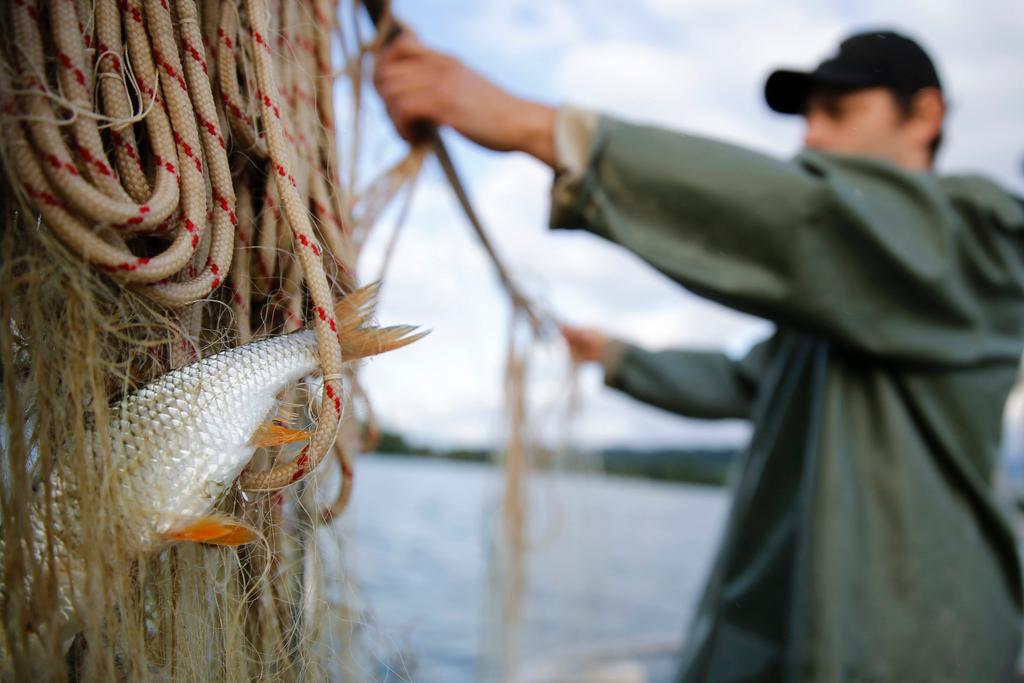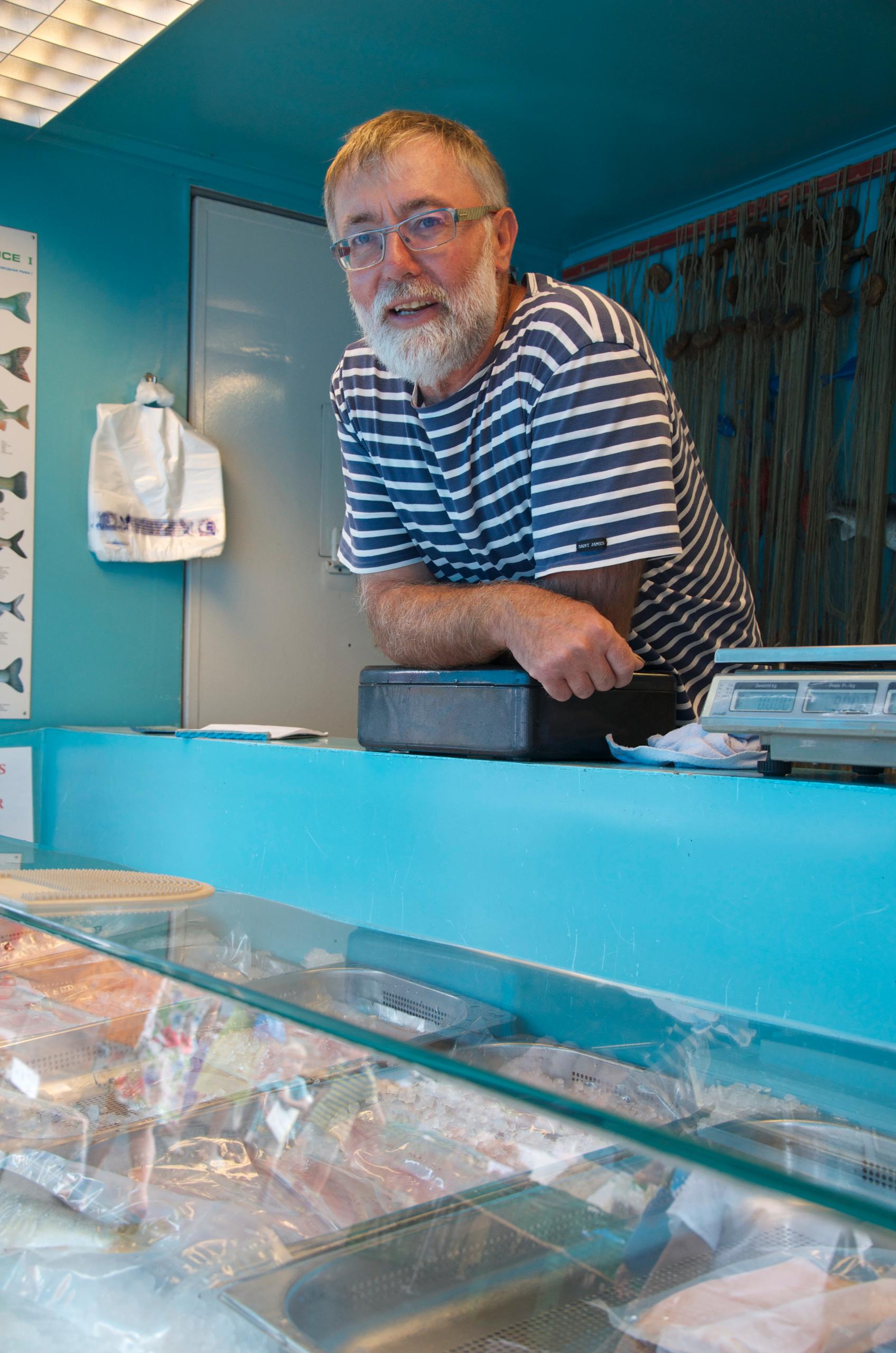
Net tightens on fishing profession

While some 150,000 people fish for pleasure in Switzerland, there are only a couple hundred professional fishermen left in the country. Complex environmental and other challenges threaten the livelihoods of those remaining.
It’s 4.30am when Henri Daniel Champier arrives at his fishery in Clarens by Lake Geneva. The sky is still dotted with stars and only the gentle jangling of masts breaks the silence.
Champier turns on the motor of his boat and heads towards the area, five kilometres from the shore, where he cast his nets yesterday evening. He scans Lake Geneva with his binoculars until he spots the light indicating the location of his kilometre-long line of nets.
Fifteen minutes later, he is hauling up the first of eight nets by hand and disentangling an energetic trout.
Champier is one of Switzerland’s 284 professional fishermen – only a third as many as there were in 1970 – and one of only 181 who still exercise the activity full time.
The decline is not surprising as some freshwater fish are no longer as abundant as they once were. According to Maxime Prevedello, spokesman for the Swiss Fishing Federation (SFV) in French-speaking Switzerland, fish have become increasingly scarce in many lakes because they have less to feed on.
Phosphorous – the good and bad
“That is particularly true of lakes Lucerne, Brienz and Walen, where the number of fish has dropped significantly and fishing is no longer profitable,” he says.
The population boom and economic growth that followed the Second World War led to large quantities of phosphorous – notably from detergents, fertilisers and human waste – making their way into Swiss waters.
High concentrations of phosphorus trigger the excessive growth of algae, which form floating mats on the water’s surface. When the algae die, they sink, decay and reduce oxygen levels in the water, killing fish and other organisms.
But phosphorus also favours the production of phytoplankton, providing abundant food for fish such as perch, which are more resistant than many other species.
The installation of numerous wastewater treatment systems in the 1970s, a ban on washing powder containing phosphates in 1986 and the introduction of more environment-friendly agricultural methods in the 1990s drastically reduced the phosphorus level in most Swiss waters.
That hasn’t pleased everybody.
Shrinking catches
Swiss, Austrian and German fishermen on Lake Constance were dismayed to see their catches shrink by 16% between 2012 and 2013. The concentration of phosphorus in 2013 was only seven micrograms per litre, a huge drop from the peak of 86 micrograms in 1986.
The fishermen, supported by the SFV, proposed that the level of phosphorus in Lake Constance be increased via the wastewater treatment systems. Their proposal was rejected by the Federal Office for the Environment (BAFU).
The average phosphorus concentration in European waters is 100 micrograms per litre. In Lake Geneva, it has shrunk from its all-time high of 90 in 1976 to 20 micrograms per litre. The International Commission for the Protection of Lake Geneva (CIPEL), the Franco-Swiss body responsible for monitoring water quality, wants to reduce it even further – to between 10 and 15 micrograms by 2020.
Audrey Klein, secretary general of CIPEL, points out that it was the fishermen who first drew attention to the pollution because of the algae they were hauling in.
“Before the pollution, their catch tonnages were good,” she says. “If we were to reach our objective, there would not be a drastic reduction in fish, but the variety of species they catch would alter, to the detriment of species such as perch, which prefer waters containing phosphorus.”

Noble species
She adds that the conditions created would favour “a return of the noble species”, salmanids such as trout and Arctic char.
Fishermen caught record numbers of perch in the polluted waters of Lake Geneva between 1950 and 1975. Perch fillets are a popular dish but, according to Prevedello of the fishing federation, “Lake Geneva barely manages to provide more than 15 % of the perch served in restaurants”.
Fisherman Champier says most of his regular customers at his fishery and Vevey market buy whatever he catches. His wife Brigitte, a former chef, gives them recipes.
“That really helps,” says Champier, as he continues to patiently haul in his nets. “There are so many things you can do with the [fish], you just need to know how to prepare them.”
He has already filled two crates with whitefish. The sun is slowly rising from behind the mountains and a group of hungry cormorants has appeared. Champier curses the birds hovering above his nets and raps a stick against his boat to frighten them away.
Cormorants were spotted nesting in Switzerland in 2001 for the first time since the Middle Ages. There are now some 1000 nesting couples, mostly in lakeside bird sanctuaries, as well as between 5000 and 6000 cormorants that winter here.
Cormorants
A cormorant eats 500 grams of fish per day. The birds enrage fishermen by feeding from their nets and cages, tearing their nets and injuring the fish, rendering them unsellable.
Prevedello, who says it is a bad year for perch, blames the cormorants.
But cormorants are not the only problem facing fishermen. According to the environment office, 58% of indigenous fish are endangered.
“What do you expect?” says Champier. “Only 3% of the shores are natural. The fish have nowhere to reproduce.”
The law on the protection of waters requires cantons to plan and implement measures to restore streams, rivers and lakes to a more natural state within the next 80 years. The federal government has earmarked CHF40 million per year to help them.
The law also stipulates that hydroelectric plants must reduce their negative impact on the environment by 2030.
“There are hydroelectric installations on 90% of Swiss waterways,” says Prevedello. “The small installations in particular have caused a lot of damage by sectioning waterways and preventing fish from migrating up and downstream. In Bern, for example, they can no longer reach the areas where they reproduce because of the dams on the Aare.”
Hydropower
Hydroelectric plants and dams also generate strong fluctuations in water levels and flows, disrupting the natural flow variations essential to many species’ reproduction cycles.
Following Switzerland’s decision to phase out nuclear power by 2034, the government will increase the number of hydroelectric power installations by 6% by 2035. Prevedello says the Swiss Fishing Federation, which has joint projects with WWF and Pro Natura, is “very worried”.
Micropollutants from pesticides, fertilisers, detergents, cosmetics and medication are another cause for concern. Even small quantities can harm aquatic flora and fauna and pollute drinking water.
To halve the quantity of micropollutants, the government intends to equip 100 of the 700 wastewater treatment systems with an additional procedure over the next 80 years. It has calculated the cost at 1.2 billion francs – CHF60 million per year.
Fish on ice
Champier is returning to his fishery. He has caught 42 kilos of whitefish and two trout, which he will wash, gut, scale, cut and put on ice.
These are skills that Mélissa Defago, 19, is learning. Last year, she dropped out of an apprenticeship and started helping a fisherman in Le Bouveret, canton Valais.
“I love being on the lake and the contact with nature,” says Defago. Next year, if her application for a fishing licence is successful, she will boost the number of professional fisherwomen to 15.
Champier worked in an office to please his parents before following the call of the lake 37 years ago. Despite the challenges, he says if he could turn back the clocks and start again, he would still choose to be a fisherman.
National Fishing Day
Switzerland’s second National Fishing Day takes place on 29 August. In 2013, the public took part in more than 50 activities organised by cantonal fishing federations and local amateur clubs.
“It’s important for us to convey a positive image of fishing to the public and inform them of the different possibilities,” says Prevedello, SFV spokesman for French-speaking Switzerland.
Training for professional fisherpeople
No formal training exists but all commercial fisherpeople must have a professional fishing licence. Licences are limited and issued by the cantons responsible for each lake. Applicants must have a boating licence and take an exam that covers practical and theoretical aspects of fishing as well as legislation relating to fishing, nature protection and hygiene. If more than one person applies for a licence, it goes to the person with the best exam results.
Training for amateur fisherpeople
Nobody can fish without buying a daily, weekly, monthly and annual. Since 2009, under the Animal Protection Law, anyone wishing to obtain a fishing permit for more than 30 days must demonstrate sufficient knowledge and skills by taking an exam to obtain a certificate, the Sachkundenachweis (SaNa).
Courses are organised by the Fisherpeople’s Training Network and take place over two half days. Permit prices vary according to the canton that issues them and which river or lake they are for.
Each canton publishes guidelines on best practices.
Fisherpeople’s Training Network
http://www.formation-pecheurs.chExternal link

In compliance with the JTI standards
More: SWI swissinfo.ch certified by the Journalism Trust Initiative





























You can find an overview of ongoing debates with our journalists here . Please join us!
If you want to start a conversation about a topic raised in this article or want to report factual errors, email us at english@swissinfo.ch.